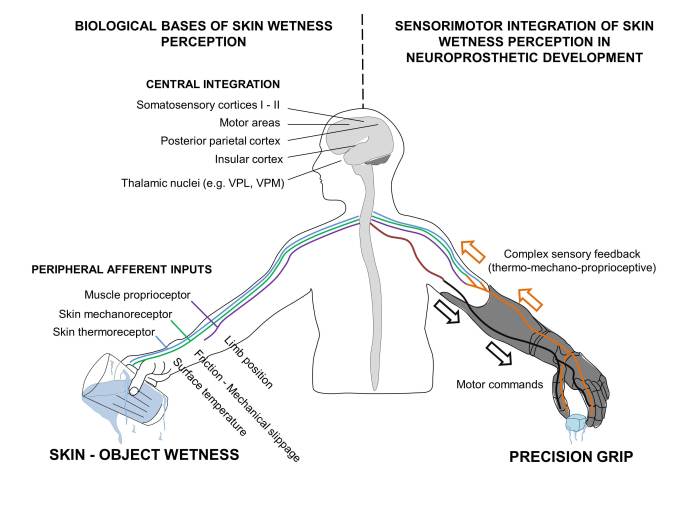We know that sensing skin wetness is critical in the context of human behavioral and autonomic thermoregulation. However, sensing skin wetness has important implications for object manipulation and manual function. In this recent Journal of Neurophysiology review we explore the biology of wetness sensing, its role in manual function, and the potential for its replication in upper limb neuroprosthetics.
Enjoy the read!
Abstract
Our perception of skin wetness is generated readily, yet humans have no known receptor (hygroreceptor) to signal this directly. It is easy to imagine the sensation of water running over our hands, or the feel of rain on our skin. The synthetic sensation of wetness is thought to be produced from a combination of specific skin thermal and tactile inputs, registered through thermoreceptors and mechanoreceptors, respectively. The present review explores how thermal and tactile afference from the periphery can generate the percept of wetness centrally. We propose that the main signals include information about skin cooling, signaled primarily by thinly-myelinated thermoreceptors, and rapid changes in touch, through fast-conducting, myelinated mechanoreceptors. Potential central sites for integration of these signals, and thus the perception of skin wetness, include the primary and secondary somatosensory cortices and the insula cortex. The interactions underlying these processes can also be modeled to aid in understanding and engineering the mechanisms. Further, we discuss the role that sensing wetness could play in precision grip and the dexterous manipulation of objects. We expand on these lines of inquiry to the application of the knowledge in designing and creating skin sensory feedback in prosthetics. The addition of real-time, complex sensory signals would mark a significant advance in the use and incorporation of prosthetic body parts for amputees in everyday life.

In the figure: Schematic of peripheral afferent inputs that may contribute to wetness perception.
The left side of the figure shows that thermoreceptive and mechanoreceptive afferents contribute to detecting and perceiving skin wetness. The right side of the figure shows how these signals may be recovered and used in a neuroprosthetic device, signaling both efferent motor commands and complex sensory feedback. The central areas that may generate the perception of wetness include those activated by tactile and thermal inputs (shown), as well as being subject to multisensory influences (e.g. vision) and cognitive processes (e.g. attention, learning).
No comments:
Post a Comment